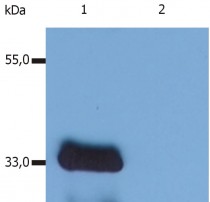ARG63060
anti-LIME antibody [LIME-10]
anti-LIME antibody [LIME-10] for IHC-Formalin-fixed paraffin-embedded sections,Western blot and Human
Immune System antibody
Overview
| Product Description | Mouse Monoclonal antibody [LIME-10] recognizes LIME |
|---|---|
| Tested Reactivity | Hu |
| Tested Application | IHC-P, WB |
| Specificity | The clone LIME-10 reacts with the cytoplasmic domain of LIME, a 30 kDa Lck-interacting transmembrane adaptor expressed by T cells. |
| Host | Mouse |
| Clonality | Monoclonal |
| Clone | LIME-10 |
| Isotype | IgG2a |
| Target Name | LIME |
| Antigen Species | Human |
| Immunogen | COOH-terminal peptide comprising residues 281-296 of the human LIME conjugated to keyhole limpet hemocyanin. |
| Conjugation | Un-conjugated |
| Alternate Names | Lck-interacting molecule; Lck-interacting membrane protein; Lck-interacting transmembrane adapter 1; dJ583P15.4; LIME |
Application Instructions
| Application Suggestion |
|
||||||
|---|---|---|---|---|---|---|---|
| Application Note | * The dilutions indicate recommended starting dilutions and the optimal dilutions or concentrations should be determined by the scientist. |
Properties
| Form | Liquid |
|---|---|
| Purification | Purified from ascites by protein-A affinity chromatography. |
| Purity | > 95% (by SDS-PAGE) |
| Buffer | PBS (pH 7.4) and 15 mM Sodium azide |
| Preservative | 15 mM Sodium azide |
| Concentration | 1 mg/ml |
| Storage Instruction | For continuous use, store undiluted antibody at 2-8°C for up to a week. For long-term storage, aliquot and store at -20°C or below. Storage in frost free freezers is not recommended. Avoid repeated freeze/thaw cycles. Suggest spin the vial prior to opening. The antibody solution should be gently mixed before use. |
| Note | For laboratory research only, not for drug, diagnostic or other use. |
Bioinformation
| Database Links |
Swiss-port # Q9H400 Human Lck-interacting transmembrane adapter 1 |
|---|---|
| Gene Symbol | LIME1 |
| Gene Full Name | Lck interacting transmembrane adaptor 1 |
| Background | LIME (Lck-interacting molecule) is a 30 kDa double-palmitoylated protein with unusually basic cytoplasmic domain, expressed by T cells. After ligation of CD4 or CD8 T cell coreceptors, LIME is phosphorylated by Src-family kinases and associates with Lck and Fyn kinases and with their negative regulator Csk. Interestingly, Csk-mediated phosphorylation of C-terminal negative-regulatory tyrosine of LIME-associated Lck can result in increase of enzymatic activity compared with the total pool of Lck, thus, LIME serves as a positive regulator of TCR-dependent T cell signaling. However, under some circumstances, LIME may mediate inhibitory signals. |
| Function | Involved in BCR (B-cell antigen receptor)-mediated signaling in B-cells and TCR (T-cell antigen receptor)-mediated T-cell signaling in T-cells. In absence of TCR signaling, may be involved in CD4-mediated inhibition of T-cell activation. Couples activation of these receptors and their associated kinases with distal intracellular events such as calcium mobilization or MAPK activation through the recruitment of PLCG2, GRB2, GRAP2, and other signaling molecules. [UniProt] |
| Research Area | Immune System antibody |
| Calculated MW | 31 kDa |
| PTM | Palmitoylation of Cys-28 and Cys-31 is required for raft targeting. Phosphorylated on tyrosines upon TCR activation and/or CD4 coreceptor stimulation, or upon BCR stimulation; which leads to the recruitment of SH2-containing proteins. |
Images (1) Click the Picture to Zoom In








